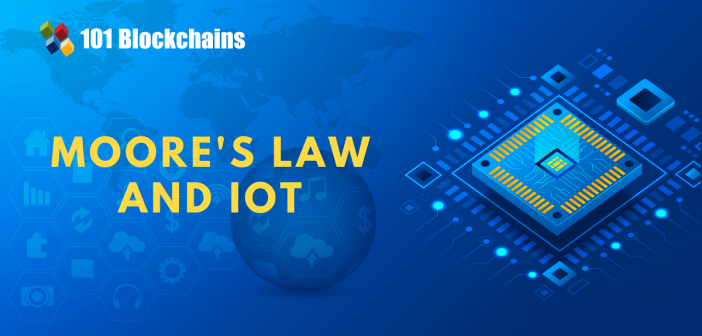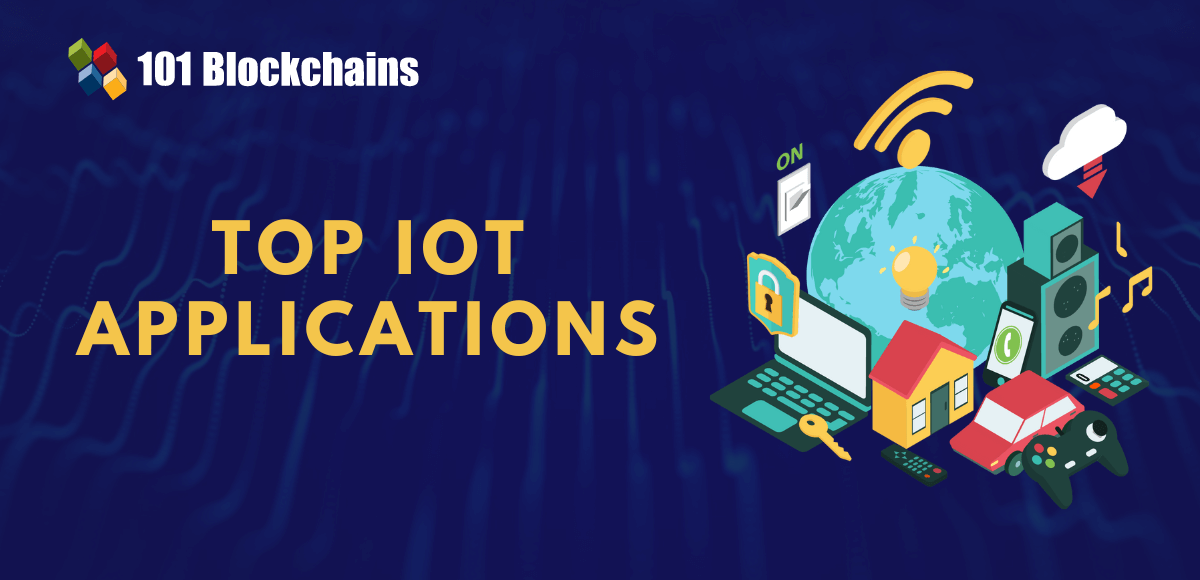Learn how blockchain truly works, master key definitions, and uncover what makes smart contracts so "smart." Dive into the fundamentals, gain valuable insights, and start your blockchain journey today!

- IoT
Gwyneth Iredale
- on October 11, 2021
Moore’s Law and the Internet of Things (IoT)
Wondering what is Moore’s law and how is it related to the Internet of Things? Well, we’ve created this guide to get you covered. Let’s dive in!
Many people do not have a clear idea regarding the potential impact of IoT. At the same time, there are conflicting opinions regarding the actual value of IoT and the hype surrounding IoT. In addition, many skeptics also point out the possibilities for stalled growth in the IoT landscape.
On the other hand, the evolution of IoT has reached a point where it is being considered as the next biggest frontier of technology. So, what is the world missing in anticipating the true potential of IoT? The answer to this question is clearly evident in Moore’s law. The following discussion helps you obtain a detailed impression of the law and how it relates to the domain of IoT.
Will the IoT Hype Last Long?
One of the foremost things about new technology is the hype created around it. In most cases, the initial hype regarding a new technology does not match with the content in it. The same has happened in the case of IoT due to the concentrated focus on new devices rather. Therefore, there has been no attention to the interaction between devices, applications, and data or the possibilities for integration of all the devices and systems. At the same time, devices will also play an important role in expanding the future growth of IoT. This is where you would find Moore’s law IoT relationship.
The increasing number of IoT devices and the introduction of new device form factors could work as a trigger for organizations to work on the management of data flow between IoT devices and applications. The new IoT landscape should not focus on presenting information to users from a back-end or cloud system. On the contrary, the definition of an application should be based on the interaction of devices, apps, users, and data. Moore’s law formula is the concept that offers the necessary support for explaining the future prospects of IoT.
Want to learn how you can use blockchain in the Internet of Things (IoT)? Enroll in Getting Started with Blockchain And IoT Course Now!
Definition and Origins of the Law
If you want to know why Moore’s law is important, then you need to understand its definition and its origins. The law is basically an observation that suggests that the number of transistors bundled in a computer chip would double up at a gap of every two years. An increase in the number of transistors would empower growth in processing power. In addition, the law also implies the possibility of a reduction in cost per transistor with the increasing number of transistors. Therefore, the law states that the processing power of computer chips would grow, and the cost of each transistor would decline in an exponential manner.
Over the last five decades, Moore’s law has been one of the important tools for accurate predictions regarding developments in computer technology. Co-founder of Intel, Gordon Moore, came up with the concept around 1965 with his prediction that the number of transistors in a computer chip would reach almost 65,000 by 1975. Subsequently, Moore revised his assumptions with new data suggesting that processing power would double up at an interval of two years. The law has been serving as a benchmark for computer engineers and scientists to come up with new advancements.
However, many assumptions point out the need for finding answers to ‘Is Moore’s law still valid in 2021?’ which need clarification. The number of transistors for each chip has gone from 3500 to almost 50 billion since the origin of the law. On the other hand, the growth in capacity predicted in the law would ultimately lead to a wall. It is clearly evident that transistors would become so small after a specific point in time. As a result, the impact of quantum physics could restrict the abilities of transistors for proper functioning. So, is Moore’s law still relevant for 2021?
Want to understand the fundamentals of the Internet of Things (IoT)? Enroll now in IoT Fundamentals Course!
Moore’s Law Formula
The next important thing to develop a basic understanding of the law refers to Moore’s law formula. Since you are looking for a law, it is reasonable to seek a quantified representation of the law. It is important to know that Moore did not introduce a specific equation or formula for his concept. Therefore, you can end up with confusion while trying to find out ‘what is Moore’s law formula?’ to understand it. The simplest formula for explaining the law is as follows.
Processing Power in Future = Existing Processing Power. 2n
Here ‘n’ represents the number of years required for developing a new microprocessor, divided by two. Let us take an example to understand the law better. The Intel 8008 had around 3500 transistors in 1972. After 10 years, how many transistors can you expect in the microprocessor? In this case, the time difference is 10 years, thereby implying that ‘n’ will be 5. Therefore, you can use the formula as follows,
Processing Power in Future = 3,500. 25
So, you could find out the processing power in the future at 112,000. Intel released the 286 processor in 1982 with around 134,000 transistors, thereby implying closeness to Moore’s prediction.
Start learning Blockchain IoT with World’s first IoT (Internet Of Things) Skill Path with quality resources tailored by industry experts Now!
Moore’s Law and IoT
Technology engineers and specialists have been able to leverage Moore’s law effectively in the domain of semiconductors. The law has definitely helped in stuffing up massive computing capabilities in desktops, wearables, smartphones, and laptops. The growth of IoT has prompted the proactive use of the law by Moore for delivering a value model for new technologies and capabilities. Just like the explanation for the number of transistors on an integrated circuit, the law also offers a credible explanation for the faster growth of IoT-supporting networks.
Validity of Moore’s Law in Present Times
The association of the law by Gordon Moore with IoT started immediately after establishing the concept. IoT started with the integration of computing capabilities in machines or embedding. Embedding offered the exceptional capability for controlling the machines alongside extracting data from them. The second phase in the evolution of IoT introduced cloud computing with dramatic changes in scalable computing power.
Cloud computing enabled cost-effective and flexible access to networking, storage, and servers. Now, the domain of IoT is in its third stage of evolution, with new IoT devices capable of generating data and becoming connected. In addition, IoT devices are developing capabilities for offering previously inaccessible information by leveraging big data analytics.
As the demand for interconnectivity among different types of IoT ecosystems increases, the answer to ‘Is Moore’s law still valid in 2021?’ becomes clear. Many people do not understand the promising revolutionary implications associated with the law. It implies that we can see more IoT devices at lower cost and with better pervasiveness alongside the development of new and innovative ways for using IoT.
Want to familiarize yourself with the technology stack associated with IoT? Enroll now in Internet Of Things (IoT) – Intermediate Level Course!
Impact of Moore’s Law on IoT
In order to understand “why is Moore’s law important for IoT,” you need to understand the implications it has for IoT. First of all, the law implies that people could invest in IoT devices with low costs since the initial cost of IoT devices would drop. At the same time, you will have sustainable revenues. The decrease in initial costs also removes the barrier to entry while ensuring the involvement of more people in the IoT domain. Without any changes to the law, the IoT landscape could lead to the opening of a massive emerging market.
Moore’s law IoT relationship would also imply the possibilities for the creation of massive secondary markets for the IoT asset exchanges. The exponential growth in IoT devices would offer a formidable boost for tokenization and trading of assets in IoT ecosystems.
As a result, we can look at a future that implies possibilities for people earning regular income with IoT assets. The radical adoption of IoT devices should not instill the fear of automation. On the contrary, the growth in the number of IoT devices should actually serve as an opportunity.
Want to know more about blockchain technology? Check out our ultimate blockchain definitions guide right now!
Factors Affecting Moore’s Law Implications in IoT
The importance of Moore’s law in the Internet of Things would stay relevant only with the attention to three distinct factors. As of now, the interrelated forces of power, size, and heat present notable doubts regarding the shrinking of the size of transistors. In addition, many assumptions also point out the impractical nature of shrinking transistors or chips beyond a certain limit. On the other hand, chip pathways could not become shorter than a molecule due to physical limits. So, it is important to look for credible solutions such as multicore microprocessors or stacked semiconductors.
Final Words
As the world warms up to the adoption of IoT devices and networks, Moore’s law becomes more relevant than ever. The law provided a strong foundation for the Internet of Things many decades ago. It was a functional tool for understanding the true potential of enhancing computing capabilities in IoT ecosystems. Most important of all, the law will be valid for a long time from now.
However, it does not focus only on validating the possibilities for increasing the number of IoT devices to billions. The law changes the definition of applications in IoT and can set effective benchmarks for digital transformation in the future. Learn more about IoT right now and explore its full potential.






